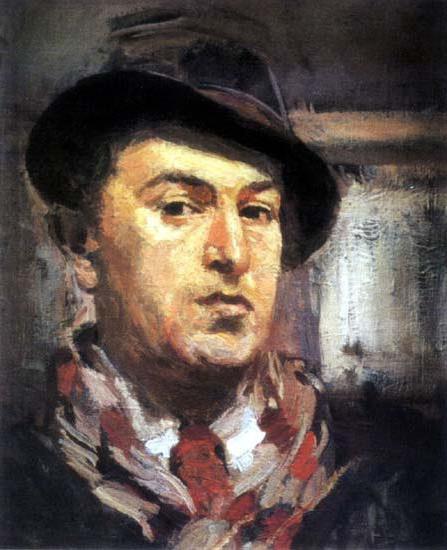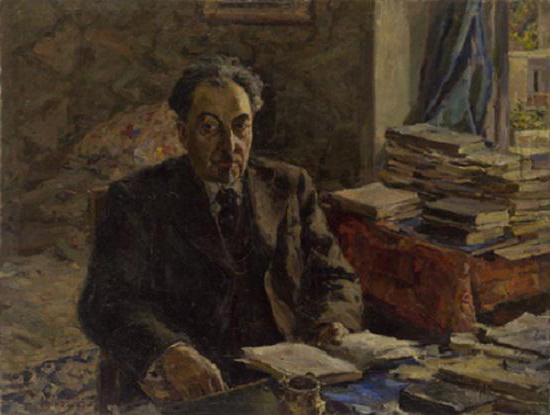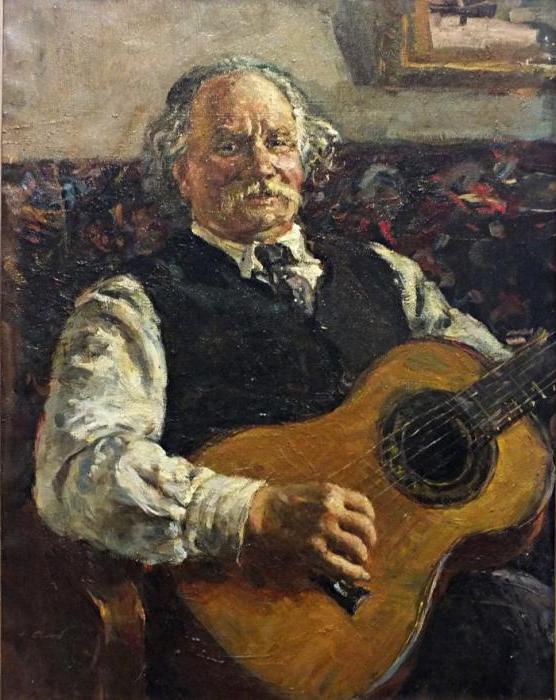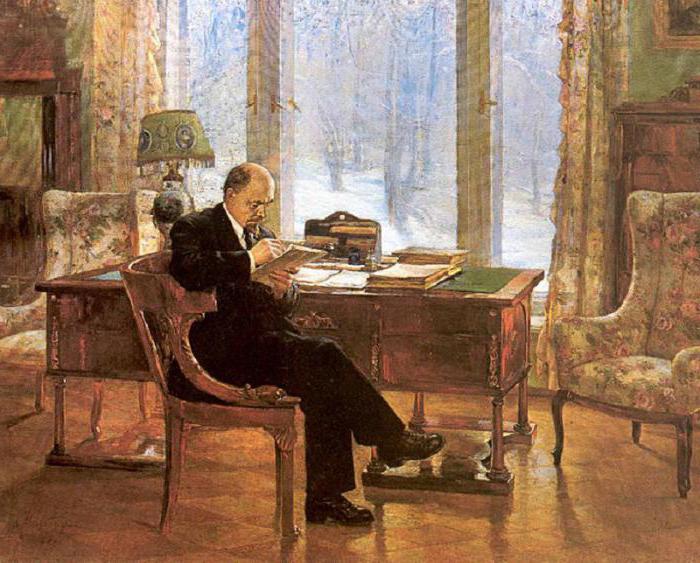It can definitely be argued that the painting of the Soviet period by our art historians has not been studied enough. The work of the great master of portraiture, landscape, still life, such as Dmitry Arkadievich Nalbandyan, was not given due attention, therefore, after 1991, many of his works were abroad. Remaining in Russia are highly valued at auctions. His Crimean landscapes in 2006 were very expensive lots. Their starting price was an amount of 80 thousand dollars.
Childhood and youth in Tiflis
In a large and poor family of a stoker worker in 1906, on September 15, a son was born who was affectionately called Mito. The father dreamed that his son would get an education and beat himself out in people. The child received knowledge in the Russian gymnasium. The drawing teacher noticed his outstanding data, and his parents welcomed the drawing lesson in every possible way. Much later, the artist will write his best work: “Portrait of the Mother”.
But when the boy was a teenager and he was 12 years old, his father died at the hands of terrorists. Mito got a job as a
laborer in a brick factory. But the craving for art was great, and Dmitry first went to an amateur art club, then to a preparatory art school, and then worked with the sculptor Khmelnitsky, who noticed his abilities and began to gradually train a young man.
In 1922, the future artist entered the art school. After him - to the Tbilisi Academy of Arts of Georgia in 1924, which he graduated in 5 years. He studied under E. Tatevosyan and E. Lansere. His thesis was the work "Young Stalin with his mother in Gori." He began his work at the Goskinoprom as a cartoon artist, and then at the Odessa film studio as a production designer. Before continuing our biography, we will see how Nalbandyan looked in his youth.
1932 self portrait
The young painter created his portrait when he came to work in Moscow, where no one knew him. Sociable and cheerful, he quickly became acquainted with the leading artists of the country (D. Moor, I. Grabar, S. Merkurov, A. Gerasimov, P. Radimov) and learned a lot from them. This is evident from the self-portrait of Nalbandyan, painted in silver and black. Bright light falls on a serious thoughtful face, allowing you to examine every detail: eyebrows striking, large dark eyes, beautiful sculpting of the lips. The head is decorated with a fashionable velor hat, and affiliation with the workshop of free artistic people shows a carelessly tied red-white scarf, which draws attention to a beautiful face even more.

This calm confident man has already written a number of works that have been approved in newspaper publications. He is not going to stop there, but will continue to grow further. D. Nalbandian will paint his portraits more than once, one of which has been located in Florence in the famous
Uffizi Gallery since 1982
. Since the XVII century, they began to collect a collection of self-portraits here. Famous portrait painters and artists around the world considered it an honor to put their portrait in the gallery. From Russia it was first O. Kiprensky, then I. Aivazovsky, later B. Kustodiev.
1931 year. Moscow
In the capital, D. Nalbandyan continues to work in films at Mosfilm, and also publishes his drawings in the Crocodile magazine and in satirical newspapers. Such activity does not suit young Dmitry Arkadyevich. He wants to do painting, but he understands that knowledge and skills are not enough. The artist spends long hours in museums, gets acquainted with the works of classics in order to learn how to build a finished painting and master the pictorial and plastic means. Turning to the landscape, he works in the open air. During these years, the romantic landscape "Road to the Ritsa" was created.
Using a silver-blue palette, he conveys the harsh beauty of the Georgian mountains and the rapid movement of the river. He also writes still lifes, portraits and thematic paintings. In 1935, a large work was written: "Speech by S. M. Kirov at the 17th Party Congress." She was very approved in the press. Inspired by artist Nalbandyan
at
In 1936 he painted the painting “Speech by A. I. Mikoyan at the Second Session of the All-Russian Central Executive Committee” and exhibited it, like other painters, in Stalin in the Donbass in 1941. When the Germans occupied this industrial city, all cultural values disappeared. Where are they? This secret has not been revealed to this day.
During the war
In this terrible period, the artist Nalbandyan moves to Armenia and helps to open a branch of “TASS Windows”. He creates political posters, caricatures, and also goes to the front, collecting materials for paintings. Dmitry Alexandrovich does not leave painting, and in 1942 he paints a picture of the battle, of which he was a witness, "The Last Order of Colonel S. Zakiyan." The mortally wounded division commander during the battle for the Crimea on the Kerch Peninsula until the end remains at his post and leads the battle. This is a very intense and dramatic canvas. At the same time, the Armenian artist shows how the women of Armenia, preparing assistance to the front, spin the wool. The large canvas is called "Gifts to the Front." Traveling a lot in Armenia, Nalbandyan gets acquainted with her people and turns to portraits. In 1943, he created the image of the outstanding Armenian poet A. Isahakyan.

The artist shows us a thoughtful, deep man, surrounded not by manuscripts, but by books. He looks like a professor, not a poet who is visited by muses. The painter gets acquainted with cultural workers and also paints portraits of artists S. Kocharian, A. Aydinyan, poet N. Zoryan, musician K. Erdeli. Deep revealing their images, Nalbandyan proved himself to be a magnificent portrait painter, following the best traditions of the Russian school of painting. He also manages to work on such group portraits as the “Excellent Company” paintings, in which the leaders of the allied countries are present: I. Stalin, W. Churchill, T. Roosevelt, as well as the “Crimean Conference”. In addition, the Armenian artist travels a lot in the republic and often paints landscapes in the Ararat valley, on Lake Sevan, the ancient city of Ashtarak,
old Yerevan with narrow, tangled streets. Repeatedly returning to Armenia after the war, the artist, admiring the sunny sultry country, paints her landscapes with snowy Ararat again and again, takes from life the return of shepherds from the mountains, dancing collective farmers, building a new Yerevan. Having completely switched over, he also writes a large group portrait of figures of Armenian culture “Vernatun” (1978). Therefore, it is fully justified that in 1965 D.A. Nalbandian was awarded the high title of People's Artist of the Armenian SSR.
After the war
D.A. Nalbandian believed that portraits reflect the time in which he lives, and saw his obligation to capture all the leaders of the country. Therefore, he gladly transferred to the canvases the images of political figures. Especially I. Stalin, who only allocated him ¾ hours for posing. Based on these cursory sketches made from a living person, many portraits of the country's leader will be further written. Members of the Politburo, military men of the highest ranks, and politicians (Ordzhonikidze, Kalinin, Voroshilov, Budyonny, Mikoyan, Tolyatti, Gromyko, Ustinov) come to his studio to order portraits. A very interesting portrait of the artist P. Radimov (one of the founders of AHRR) with a guitar. Pavel Alexandrovich is depicted at home.

On a simple, very Russian face (it was a native of peasants) a smile plays, and his eyes sparkle with fun. The portrait turned out bright and cheerful. The artist Nalbandyan is also interested in ordinary working people. He paints portraits of factory workers (Andreev, Petukhov, Polyushkin), collective farmers (poultry houses Svetlova, milkmaids Stashenkova). He sees their different states and reveals to us the souls of his models, full of generous kindness.
Portraits of V. Lenin
A huge public temperament forced the artist after the war to turn to the creation of images of Lenin. He wrote a series of paintings depicting Vladimir Ilyich. The most significant work on this subject is “Lenin in the Gorki”. It shows the leader of the world proletariat for hard work. D. Nalbandian had to "compete" with the classic images of Vladimir Ilyich I. Brodsky, which everyone knew from numerous posters and postcards. However, already an experienced master approached the interpretation of a well-known topic differently.

If I. Brodsky chose pastel beige colors, then D. Nalbandyan’s painting “Lenin in the Hills” is dominated by golden brown tones and a bluish-white winter landscape outside the window. They highlight a small figure of Lenin in a black suit, which becomes dominant. Vladimir Ilyich sits in the center of the room sideways to the table, ready to break away from his work, if necessary. The table is covered with green cloth. On it is a table lamp, which is useful for work in the evening, neatly folded folders, an open notebook and a thick book. Everything speaks of the great self-discipline of the person who has deepened in the record, who holds them simply in his hands. The atmosphere is modest. Lenin sits on a chair with a comfortable semicircular, but rigid back, in addition, there are still two soft chairs. Its whole appearance expresses asceticism and focus on urgent work. She contributes to the silence that comes from the picture. In 1982, for a series of paintings dedicated to the creator of the country of Soviets, the artist received the Lenin Prize.
Still life master
One of the favorite topics in the artist’s work is a floral still life. He depicted wildflowers and garden flowers in small arms with great love for the delicate creatures of nature. Its maroon regal magnificent peonies are beautiful, graceful modest camomiles, cornflowers and bells collected in one bouquet are graceful. A floral still life is often complemented by porcelain plates filled with strawberries, cherries or just a cup and saucer. Lush, bright asters are adjacent to him next to the fruits of late summer - watermelon with red pulp, clusters of black and white grapes, gray plums, velvety peaches. Spring snow-white bird cherry, filling with its fragrant flowers the whole canvas, showers everything around with translucent petals. The artist masterfully conveyed the brilliance of steel, the transparency of glass, and the softness of fabrics.
Incredibly good are the Persian lilacs that D. Nalbandian loved to paint in huge bouquets in glass and
porcelain vases or wicker baskets. It was with a lilac that anecdotal incident occurred. The artist was invited to the birthday of sculptor Karbel, who was presented with a magnificent bouquet of lilacs. The venerable painter was so delighted with him that, as a little child, he began to beg this lilac from the birthday man. But Lev Efimovich did not want to part with the flowers. However, the organizers of the holiday presented the very same bouquet to the very distressed D. Nalbandyan the next day, and he immediately took up the brush. As a result, a still life appeared that conveys the morning freshness of lilac moist from dew.
Travel and sketching
The artist Nalbandian had complete freedom of movement not only throughout the USSR, but also abroad. Three months in 1957, he worked in a fabulous exotic India, where he created about 300 works. They show the life and life of the people, lyrical and architectural landscapes, numerous portraits of ordinary people, as well as a magnificent full-length portrait of Indira Gandhi. His work was highly praised by the Government of India. Dmitry Arkadievich was awarded the title of Javaharlal Nehru Prize Laureate .
In subsequent years, the artist traveled to Spain, Italy, Hungary, France, Japan, Bulgaria. By the way, in Japan he was called "Russian Rembrandt." From each camp he brought cycles of paintings and sketches, absolutely fantastic, which tore him off as an artist on the other hand. He took a big step forward, developing all of Soviet painting. These bright, emotional works were exhibited in 1968 at an exhibition in the Russian Museum, which was called "Unknown Nalbandyan."
Museum-workshop of Nalbandyan
It was opened by the Moscow government in 1992 in an apartment on Tverskaya, in which D.A. Nalbandyan lived since 1956. The windows of the workshop overlook the monument to Yuri Dolgoruky, and the Moscow bookstore was located below. Director M. Romm, writer I. Ehrenburg, poet D. Poor lived in the same house. The upper floor with large bright windows on the ceiling was given to artists. N. Zhukov, Kukryniksy, V. Minaev, F. Konstantinov lived and worked there.
The museum-workshop is part of the Central Exhibition Hall Manege as a unit. It is based on a meeting that the artist handed over to the city in 1992. The museum-workshop stores paintings by Nalbandyan. There are more than 1,500. As well as personal belongings belonging to the artist's family. Only here you can see that still life with lilacs about which we spoke. In addition to lilacs, the workshop exhibited still lifes with carnations, daisies, and the work “Flowers on a Blue Tablecloth”. Here is the artist’s favorite painting, which he never exhibited anywhere, painted in 1935: “Portrait of the Komsomol member V. Terekhova.” This is the wife of the artist Valentina Mikhailovna, with whom he lived a long happy life.

The artist’s sister Margarita Arkadyevna handed over to the museum unique priceless photographs showing the meetings of Dmitry Arkadyevich Nalbandyan with Indira Gandhi, A. Mikoyan, T. Zhivkov, A. Gromyko. Still were given to the museum drawings by D. Nalbandyan, his notes. The artist is little known as graphics. His drawings, portraits of Khrushchev, Brezhnev, Saryan, Roerich - a reflection of time.
The very atmosphere of the museum is modest in modern times. There is no catchy luxury of the nouveau riche of the post-Soviet times, but there is a bronze table donated by Indira Gandhi, massive bookcases, a service “Golden Deer”.
During the life of D. Nalbandyan, the first exhibition in the Manege was held in 1993.
The first solo exhibition after the artist’s death, dedicated to his 95th birthday, opened in 2001 at the Manege Central Exhibition Hall. Visitors were able to get acquainted with unique works, landscapes and still lifes that open the artist from a new, unknown side - as a lyricist and impressionist.
In connection with the 105th anniversary of the artist, in 2011 another exhibition of D. Nalbandyan opened the door to the Manege. It presented all the genres in which the master worked - portrait, still life, historical paintings, landscape. It collected canvases from various exhibition pavilions and a museum-workshop. She demonstrated how diverse was the talent of Dmitry Arkadyevich, whom they used to think of only as a “court painter”.
Memory of the artist
Dmitry Arkadievich Nalbandyan died in 1993, on July 2, having lived 86 years. Until the last days, he went up to his workshop and stood up to the easel. His grave is located at the Novodevichy cemetery. A monument is erected on it - the work of sculptor-academician Yu. Orekhov. The painter is carved from stone with a palette in his hand. He devoted 70 years of his life to creativity. His works are in the State Tretyakov Gallery, the State Russian Museum, the Museum of Modern History of Russia, and in museums of Armenia.